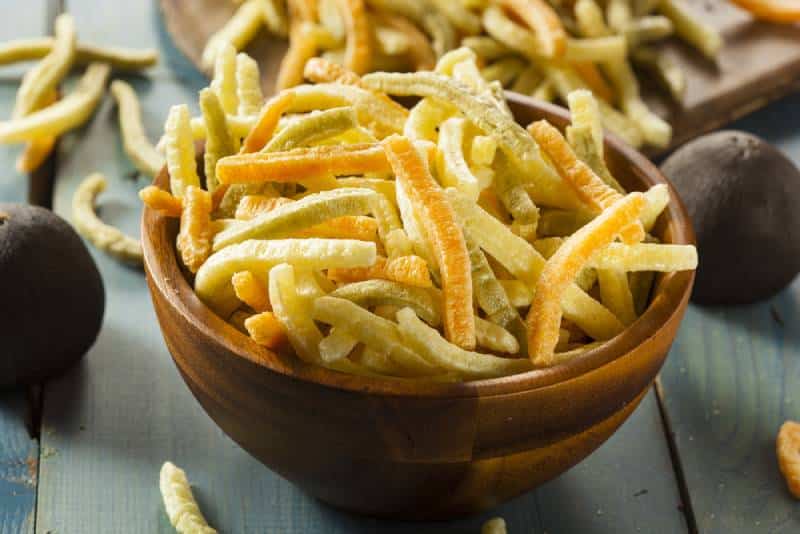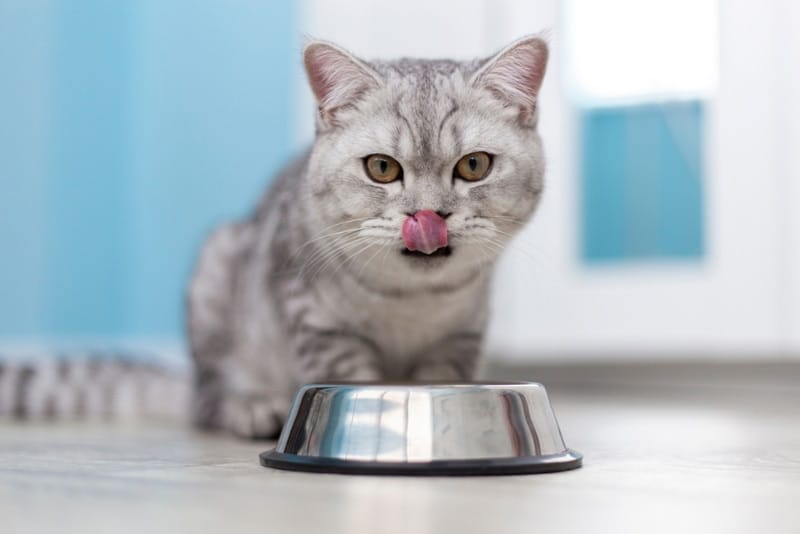A snack that is recognized as a good food for people is the Veggie Straw. These crunchy snacks are said to be a great way to increase our vegetable and nutritional intake, and who can blame us for wanting to eat healthy vegetables in a delicious way? It makes sense, if this is the case, that many pet parents would want to offer them to their cat as a healthy treat as well.
If you’re a Veggie Straw fan, you’ve probably seen your cat love to nibble on these chips, and you’ve wondered if it’s safe to share them with your furry friend. With their incredible sense of smell, cats can easily sniff out something delicious they want to eat, but sadly, and often to their dismay, Veggie Straws are not a good option to give your cat.


What are Veggie Straws?
Veggie Straws are a type of chip and a widely available snack bought in packages from stores. They are marketed and promoted as a healthy snack or treat for people due to being a fun and tasty way to add healthy vegetables to our diets, and lower fat content than the average potato chip. If we look at the actual content of these products, however, we can assume that these claims are a bit far-fetched.
Ingredients of “Sea Salt” Veggie Straws
- potato flour
- Potato starch
- corn flour
- Tomato paste
- Spinach powder
- salt
- Sugar
- Beetroot powder
- Turmeric
- Sea salt
- Oil (canola, sunflower, and/or safflower oil)
Sea salt flavor is the most basic flavor that contains the fewest ingredients. Other flavors offered include Sour Cream and Onion, BBQ, Cheese, Zesty Ranch, Screamin’ Hot and Cinnamon Apple. Many of the other flavors contain onion and garlic powder, which is the same toxic to cats. They also include cheese and milk, which many cats do not tolerate.
As we can see, Veggie Straws are far from full of nutrition for our cats, and many flavors also contain toxic ingredients, so they should not be considered a safe snack option for your cat. .
If you feed your cat Veggie Straw, check the package carefully to make sure there are no onions or garlic in the ingredients. If any of these ingredients are listed, contact your veterinarian immediately for advice.

Can My Cat Eat Veggie Straw?
Veggie Straws are created from potatoes and are a form of potato chip. Sea Salt and the Cinnamon Apple flavor contain no toxic ingredients, but they provide very little nutritional value or benefit. All other flavors offered contain toxic ingredients, so regardless of how old your furry friend is, they should not be given to your cat. Milk and cheese in many flavors can cause damage to the gastrointestinal tract as many cats are dairy intolerant.
These products are high in sodium (salt), starch, sugar, and oils. They also tend to be higher in fat and calories than many other cat-safe foods. Importantly, they contain less than 1g of protein per 28g serving, and cats need a protein-rich diet. Overall, the nutritional balance in Veggie Straws is far from ideal for a cat and can cause weight and mobility problems for your cat if fed regularly for long periods of time.
It’s perfectly fine and acceptable to want to give your cat a treat. This pleasant act helps to increase the bond between the two of you, so it’s a good thing to do as long as you choose safe food. However, there are better, non-toxic and healthier food options to choose from than Veggie Straws, and with the choice of both ready-made feline treats and plenty of safe human food options, there’s no need to give Veggie Straws your cat. Just choose an alternative!

What Treats Can I Feed Instead of Veggie Straws?
There are many store-bought products on the market to give your cat as a treat, as well as many human foods that are both safe and healthy. Try an option from the list below, though not all at once! Avoid anything your cat is allergic to or intolerant to. Remember that treats for your cat should only make up about 10% of their daily calorie intake.
Always check with your vet that the food you wish to offer is safe for your cat and their individual health status.
Safe Cat Treats
- Store-bought treats marketed for cats
- Plain grilled or cooked chicken
- Plain cooked turkey
- Cooked fish, especially salmon or oily fish
- Canned tuna in water
- Eggs
- Bananas
- Blueberries
What is a Healthy Diet for Cats?

Cats are known as obligate carnivores. This means they must get their protein from animal meat, rather than plant sources. They have some additional nutritional needs compared to dogs, humans, and other species, which are:
- Taurine – A specific type of essential amino acid found only in protein from animal meat.
- Arachidonic Acid – An essential fatty acid derived from animal sources.
- Arginine – An essential amino acid derived from animal meat.
- Vitamins A, D and Niacin – Cats cannot synthesize these vitamins enough so they must obtain them from animal tissues.
For this reason, cats must eat animal meat and cannot be fed a vegetarian or vegan diet. Nor can additional essential nutrients be added as supplements. Failure to provide your cat with taurine, arginine and arachidonic acid results in serious health issues, possibly leading to their death.
Cats also require lower levels of carbohydrates than humans and dogs and get most of their energy from proteins and fats.
Their specific dietary requirements mean that cats must be fed a high-quality, age-appropriate complete cat food to ensure they get all the nutrition they need to live long, healthy lives. .


Conclusion
There are many safe foods cats can eat as extra snacks or treats on top of their daily diet. While the number of snacks offered needs to be limited, there are plenty of tasty treats your cat can still enjoy while still providing them with quality, safe and healthy options. Veggie Straws are not a safe or healthy treatment option, so should be avoided.
If you are already feeding your cat Veggie Straws and are concerned about the effects on their health, have a chat with your vet or veterinary nutritionist who can best advise on next steps.
Featured Image Credit: Le Do, Shutterstock


